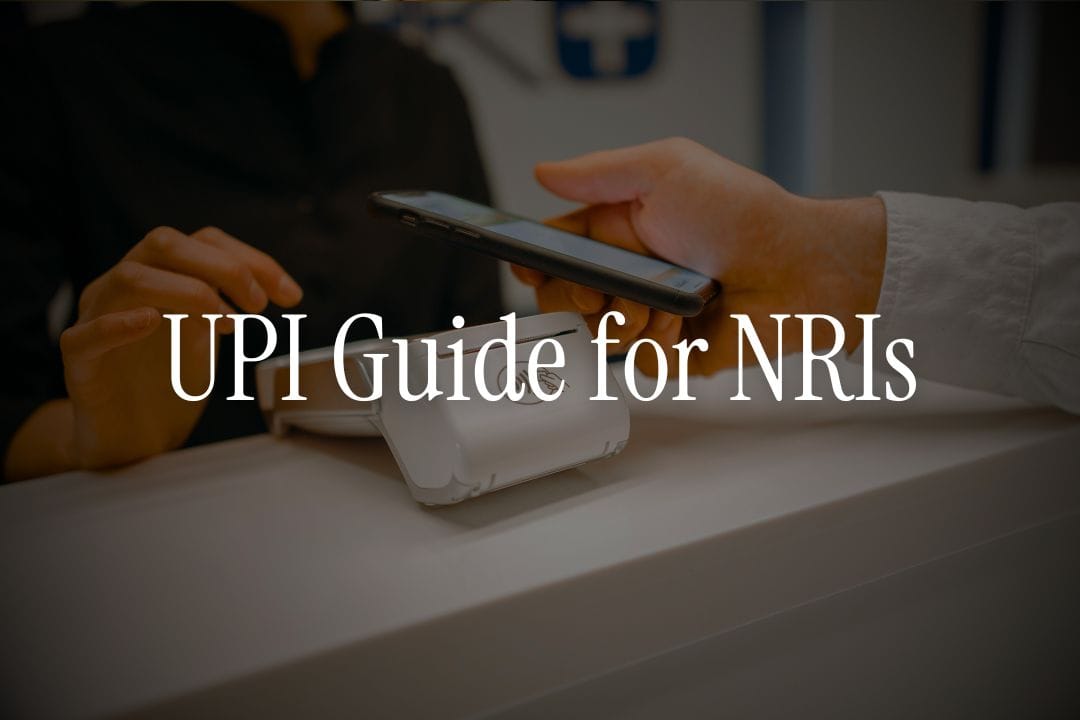
Three months ago, my friend Amit called me from London, frustrated.
"Ankur, I'm tired of paying ₹500 in fees every time I need to send money to my parents in Delhi. My cousin keeps bragging about UPI payments taking 2 seconds, but when I tried to set it up, the app said 'invalid mobile number.' Can NRIs actually use UPI or not?"
This confusion is everywhere. Every NRI WhatsApp group I'm part of has this debate.
Some say "UPI doesn't work for NRIs," others claim "I've been using it for months," and most people are just confused about what's actually possible.
Here's the reality: Yes, NRIs can absolutely use UPI, but there are specific rules, supported countries, and account requirements that most people don't know about.
The game changed dramatically in 2023 when NPCI officially enabled UPI for international mobile numbers, but the information online is scattered and often outdated.
By the end of this guide, you'll know exactly which NRI accounts support UPI, how to set it up with your international number, which banks and countries are supported, what the transaction limits are, and how to avoid the common mistakes that get NRIs stuck during setup.
The Truth About UPI for NRIs (Current Status)
Let me clear up the confusion immediately. NRIs can now use UPI with their international mobile numbers, but only under specific conditions that most articles don't explain properly.
What Actually Works:
Supported Account Types:
- NRE (Non-Resident External) accounts ✅
- NRO (Non-Resident Ordinary) accounts ✅
- Regular savings accounts ❌ (FEMA violation for NRIs)
Also Read - NRE vs NRO vs FCNR
Supported Countries:
Singapore
Australia
Canada
Hong Kong
Oman
Qatar
USA
Saudi Arabia
United Arab Emirates
United Kingdom
Europe (various countries)
Source : Paytm.com
Transaction Types Allowed:
- Payments to Indian merchants and individuals
- Bill payments within India
- Money transfers to Indian bank accounts
- QR code payments
What's Still Not Possible:
- Outbound international transfers (India to overseas)
- UPI payments to other countries
- Cross-border merchant payments
👉 Tip: The biggest mistake NRIs make is trying to use UPI with regular savings accounts. You MUST have an NRE or NRO account for UPI to work legally.
How UPI Works Differently for NRIs
Traditional UPI required an Indian mobile number, which created a catch-22 for NRIs who'd given up their Indian SIM cards. The 2023 policy change by NPCI solved this, but the implementation varies significantly by bank.
The Technical Setup
For Residents: Indian bank account + Indian mobile number = UPI access For NRIs: NRE/NRO account + International mobile number (from supported countries) = UPI access
Key Differences for NRI UPI:
Verification Process:
- Residents: SMS-based verification
- NRIs: International SMS + additional KYC verification
Transaction Limits:
- Residents: Up to ₹1 lakh per day
- NRIs: ₹5,000 for first 24 hours, then ₹1 lakh per day
App Support:
- Not all UPI apps support international numbers
- Bank-specific apps often work better than third-party apps
Supported Countries and Mobile Number Requirements
The list of supported countries has expanded significantly since the feature launched. Here's the current status:
Fully Supported Countries (2025):
Country | NRI Population | UPI Status | Key Banks |
|---|---|---|---|
🇦🇪 UAE | 3.5 million | ✅ Full support | ICICI, HDFC, SBI |
🇺🇸 USA | 4.5 million | ✅ Full support | ICICI, IDFC First |
🇬🇧 UK | 1.8 million | ✅ Full support | ICICI, HDFC |
🇸🇦 Saudi Arabia | 2.9 million | ✅ Full support | SBI, ICICI |
🇸🇬 Singapore | 750,000 | ✅ Full support | ICICI, DBS |
🇨🇦 Canada | 1.6 million | ✅ Full support | ICICI, HDFC |
🇦🇺 Australia | 720,000 | ✅ Full support | ICICI, ANZ |
🇭🇰 Hong Kong | 350,000 | ✅ Full support | ICICI, HSBC |
🇴🇲 Oman | 780,000 | ✅ Full support | SBI, ICICI |
🇶🇦 Qatar | 650,000 | ✅ Full support | SBI, ICICI |
🇲🇾 Malaysia | 350,000 | ✅ Full support | ICICI, CIMB |
🇫🇷 France | 120,000 | ✅ Full support | ICICI, BNP |
Mobile Number Requirements:
Valid International Formats:
- Must be active and able to receive SMS
- Should be registered with your NRE/NRO account
- Format: +[country code][number] (e.g., +971-50-1234567)
Common Issues:
- Temporary or virtual numbers don't work
- WhatsApp-only numbers without SMS capability
- Numbers not registered with the bank
👉 Tip: Before attempting UPI setup, call your bank to confirm your international number is properly linked to your NRE/NRO account. This saves hours of troubleshooting later.
Bank-by-Bank UPI Support for NRIs
Banks enabling UPI for international numbers includes major players like
- ICICI Bank
- HDFC Bank
- State Bank of India (SBI)
- Axis Bank
- IDFC First Bank
- AU Small Finance Bank
- Canara Bank
- City Union Bank
- DBS Bank Ltd
- Equitas Small Finance Bank
- Federal Bank
- IndusInd Bank
- Kotak Mahindra Bank
- Punjab National Bank
- South Indian Bank
- Yes Bank
Tier 1: Excellent NRI UPI Support
ICICI Bank
- App: iMobile Pay with dedicated NRI features
- Setup Time: 5-10 minutes typically
- Unique Features: International number detection, NRI-specific customer support
- User Rating: 4.2/5 for NRI UPI experience
IDFC First Bank
- App: IDFC FIRST Mobile with seamless international onboarding
- Setup Time: 3-7 minutes
- Unique Features: among early adopters of banks to offer this service, excellent NRI focus
- User Rating: ~4.4/5 for ease of setup
Tier 2: Good Support with Minor Limitations
HDFC Bank
- App: HDFC Bank MobileBanking
- Setup Time: 10-15 minutes
- Limitations: Sometimes requires additional verification calls
- User Rating: ~3.8/5
State Bank of India (SBI)
- App: YONO SBI
- Setup Time: 15-20 minutes
- Limitations: Slower customer service for international issues
- User Rating: ~3.5/5
Tier 3: Limited or Inconsistent Support
Axis Bank
- App: Axis Mobile
- Issues: Frequent verification failures, limited customer support
- User Rating: ~3.0/5
Note: The National Payments Corporation of India (NPCI) supports UPI for Non-Resident Indians (NRIs) with international mobile numbers linked to NRE/NRO accounts from 12 countries.
- Australia
- Canada
- France
- Hong Kong
- Malaysia
- Oman
- Qatar
- Saudi Arabia
- Singapore
- UAE
- UK
- USA
👉 Tip: If you're planning to open a new NRI account specifically for UPI access, ICICI Bank or IDFC First Bank offer the most reliable experience based on our testing.
Also Read - RBI Rules for NRI Accounts You Must Know
Step-by-Step UPI Setup Process for NRIs
The setup process varies by bank, but here's a comprehensive walkthrough that works for most major banks:
Pre-Setup Requirements Checklist
Essential Prerequisites:
- [ ] Active NRE or NRO account with a UPI-supporting bank
- [ ] International mobile number from supported country
- [ ] Mobile number registered with your bank account
- [ ] Smartphone with internet connectivity
- [ ] Valid debit card for the account
Detailed Setup Process
Step 1: Verify Bank Compatibility
- Log into your bank's mobile app or net banking
- Check if UPI services are available for your account type
- Confirm your international number is registered
Step 2: Download the Correct App Based on your bank:
- ICICI: iMobile Pay (not the regular iMobile app)
- IDFC First: IDFC FIRST Mobile
- HDFC: HDFC Bank Mobile Banking
- SBI: YONO SBI
Step 3: Initial Registration
- Open the app and select "Register" or "New User"
- Choose "International Number" option if available
- Enter your account details (account number, debit card details)
- Verify your identity through debit card PIN
Step 4: Mobile Number Verification
- Enter your international mobile number with country code
- Wait for SMS verification code (may take 2-5 minutes internationally)
- Enter the OTP received
Step 5: UPI ID Creation
- The app will suggest a UPI ID format: yourname@bankname
- You can customize the prefix (e.g., amit.sharma@icici)
- Ensure it's memorable but not easily guessable
Step 6: Set UPI PIN
- Create a 4-6 digit UPI PIN (different from your debit card PIN)
- Confirm the PIN
- Enable biometric authentication if desired
Step 7: Account Linking
- Select which NRE/NRO account to link with UPI
- You can link multiple accounts but need separate UPI IDs
- Verify account details
Step 8: Test Transaction
- Start with a small test payment (₹10-100)
- Send to a trusted contact or make a small bill payment
- Verify the transaction completes successfully
Common Setup Issues and Solutions
Issue 1: "Invalid Mobile Number" Error
- Cause: Bank doesn't have your international number updated
- Solution: Call NRI customer service to update mobile number first
Issue 2: SMS Not Received
- Cause: International SMS delays or blocking
- Solution: Ensure international SMS is enabled; try alternative verification
Issue 3: App Doesn't Recognize International Number
- Cause: App version doesn't support NRI features
- Solution: Update to latest version or try bank's primary mobile app
Issue 4: "Account Not Eligible" Message
- Cause: Regular savings account instead of NRE/NRO
- Solution: Convert account type through bank branch or customer service
👉 Tip: The cooling period restriction means you can only transact ₹5,000 in the first 24 hours. Plan accordingly if you need to make larger payments immediately.
Also Read - Common Mistakes NRIs Make While Choosing an NRE Banking Account
UPI Transaction Limits and Restrictions for NRIs
Understanding transaction limits is crucial for financial planning. NRI UPI limits differ from regular UPI in several ways:
Standard Transaction Limits
Daily Limits:
- First 24 Hours: ₹5,000 (cooling period)
- After 24 Hours: ₹1,00,000 per day
- Monthly Limits: No specific monthly caps, but daily limits apply
Per-Transaction Limits:
- Regular Payments: ₹1,00,000
- Merchant Payments: ₹1,00,000
- UPI Lite: ₹500 (for small offline transactions)
Number of Transactions:
- Daily: Up to 20 transactions
- Balance Inquiries: 50 per day (new 2025 rule)
- Account Linking Checks: 25 per day
Bank-Specific Variations
Bank | Daily Limit | Per Transaction | Special Features |
|---|---|---|---|
ICICI | ₹1,00,000 | ₹1,00,000 | Higher limits for select NRI customers |
IDFC First | ₹1,00,000 | ₹1,00,000 | Instant limit activation |
HDFC | ₹50,000* | ₹50,000* | Conservative limits for new users |
SBI | ₹1,00,000 | ₹1,00,000 | Standard NPCI limits |
*Can be increased through customer service
Special Category Limits
ExistingLimit Categories:
- Insurance Premiums: Up to ₹2,00,000 per transaction
- Capital Markets (including Mutual Fund Investments): Up to ₹2,00,000 per transaction
- Collections: Up to ₹2,00,000 per transaction
- Foreign Inward Remittances: Up to ₹2,00,000 per transaction
- Initial Public Offering (IPO) Applications: Up to ₹5,00,000 per transaction
- Retail Direct Scheme: Up to ₹5,00,000 per transaction
Source: NPCI.org
Proposed Limits -September 15th 2025
Capital markets and investments: per transaction limit of Rs 5 lakh, daily cap of Rs 10 lakh
Insurance premium payments: Rs 5 lakh per transaction, Rs 10 lakh daily
Government e-Marketplace: Rs 5 lakh per transaction, Rs 10 lakh daily
Travel bookings: Rs 5 lakh per transaction, Rs 10 lakh daily
Credit card payments: Rs 5 lakh per transaction, daily cap of Rs 6 lakh
Jewellery purchases: Rs 5 lakh per transaction, daily cap of Rs 6 lakh
Business/merchant transactions: Rs 5 lakh per transaction, no daily cap
Foreign exchange retail (via BBPS): Rs 5 lakh per transaction, Rs 5 lakh daily
Digital account opening (initial funding): Rs 2 lakh per transaction, Rs 2 lakh daily
Source: Business Standard, Economics Times, NDTV
How to Access Higher Limits:
- Complete additional KYC verification
- Request through bank customer service
- Provide purpose of high-value transactions
- May require additional documentation
Restrictions Specific to NRIs
Geographical Restrictions:
- UPI only works for payments within India
- Cannot transfer money from India to overseas accounts
- International merchant payments not supported
Account Type Restrictions:
- NRE account: Full repatriation rights maintained
- NRO account: Subject to $1 million annual repatriation limit
- Cannot mix NRE and NRO funds in single UPI transaction
Regulatory Compliance:
- All transactions must comply with FEMA regulations
- Large transactions may trigger additional reporting
- Businesses payments may need additional documentation
👉 Tip: If you need to make payments above ₹1 lakh regularly, consider splitting across multiple days or request limit enhancement from your bank with proper justification.
Practical Use Cases: What NRIs Actually Use UPI For
Understanding real-world applications helps you evaluate if UPI meets your needs:
Family Financial Support
Scenario: Monthly support to parents
- Traditional Method: Wire transfer (₹1,000-2,000 fees, 2-3 days)
- UPI Method: Instant transfer, zero fees
- Annual Savings: ₹12,000-24,000 in fees alone
Real Example: Priya in Dubai sends ₹50,000 monthly to her parents in Chennai. Previously used remittance services costing ₹1,500 per transfer. Now uses ICICI UPI, saving ₹18,000 annually.
Emergency Payments
Common Scenarios:
- Medical emergencies requiring instant payment
- Educational fee deadlines
- Property maintenance urgent payments
- Festival or wedding contributions
UPI Advantage: 24/7 availability means you can send money even during Indian holidays when banks are closed.
Bill Payments and Subscriptions
Supported Services:
- Electricity, water, gas bills
- Mobile and internet subscriptions
- Insurance premium payments
- School and college fees
- Subscription services (Netflix India, Amazon Prime India)
Benefits: Avoid late payment fees and service disconnections due to delayed remittances.
Property Management
Real Estate Related Payments:
- Maintenance charges
- Property tax payments
- Tenant security deposit returns
- Contractor payments for repairs
Case Study: Rajesh owns rental properties in Bangalore while living in Toronto. Uses UPI to pay maintenance charges (₹8,000/month) and property taxes, avoiding the hassle of coordinating with property managers for payments.
Investment and Trading
Supported Investment Platforms:
- Mutual fund SIPs through various AMCs
- Stock trading platforms (Zerodha, Groww, Upstox)
- Insurance premium payments
- Fixed deposit renewals
Limitation: Maximum amounts may be restricted based on your bank's NRI trading account limits.
Shopping and E-commerce
Online Shopping:
- Amazon India, Flipkart, Myntra
- Grocery delivery (BigBasket, Grofers)
- Food delivery (Zomato, Swiggy) for family
- Medicine delivery (PharmEasy, 1mg)
Offline Shopping:
- Scan QR codes when visiting India
- Payments at local markets and shops
- Restaurant and retail payments
👉 Tip: UPI is particularly valuable for time-sensitive payments like medical emergencies or educational fees where traditional remittance delays could cause serious problems.
FEMA Compliance and Tax Implications
Using UPI doesn't change your FEMA obligations, but it does affect how you track and report transactions:
FEMA Compliance Requirements
Transaction Documentation:
- UPI transactions count toward your overall India transaction limits
- NRO account: $1 million annual repatriation limit still applies
- All transactions must be from legitimate NRI income sources
Reporting Obligations:
- Banks automatically report large UPI transactions to RBI
- Maintain records of UPI transaction purposes
- Be prepared to explain large or frequent payments
Tax Implications by Account Type
NRE Account UPI Transactions:
- Source: Foreign income (salary, overseas business)
- Tax Status: Generally not taxable in India
- Documentation: Keep proof of foreign income source
NRO Account UPI Transactions:
- Source: Indian income (rent, dividends, pension)
- Tax Status: Subject to Indian income tax
- TDS: May be deducted on certain transaction types
Income Tax Considerations
Transaction Tracking:
- UPI provides excellent digital trails for tax filing
- All payments are automatically recorded with timestamps
- Easy to download transaction history for ITR filing
Large Payment Alerts:
- Payments above ₹2 lakhs may trigger PAN verification
- Business payments may require additional GST documentation
- Investment payments automatically reported to tax authorities
Best Practices for Compliance
Documentation Strategy:
- Screenshot Important Transactions: Save confirmations for large payments
- Categorize by Purpose: Family support, investment, bills, emergency
- Maintain Source Records: Link UPI payments to legitimate income sources
- Annual Review: Reconcile UPI spending with your Indian income tax obligations
Red Flags to Avoid:
- Receiving large unexplained credits via UPI
- Making business payments without proper documentation
- Exceeding your account type's transaction limits
- Using UPI for activities prohibited for NRIs
👉 Tip: Treat UPI transactions with the same compliance seriousness as traditional banking. The convenience doesn't change your regulatory obligations.
Costs and Fees: The Real Economics
One of UPI's biggest advantages for NRIs is the cost structure, but understanding the complete economics is important:
Direct UPI Costs
Transaction Fees:
- Personal Transfers: ₹0 (completely free)
- Merchant Payments: ₹0 for customers
- Bill Payments: ₹0 in most cases
- Investment Transactions: ₹0 for UPI, platform fees may apply
Account Maintenance:
- NRE Account: ₹0-500/month depending on bank
- NRO Account: ₹0-300/month depending on bank
- UPI Service: No additional charges
Indirect Costs to Consider
Opportunity Costs:
- NRE Account: Interest rates 6-7% (tax-free)
- NRO Account: Interest rates 6-7% (taxable)
- Overseas Savings: Might offer 2-4% typically
Exchange Rate Considerations:
- UPI transactions happen in INR from your Indian account
- No real-time currency conversion like with international cards
- Need to fund Indian accounts through separate remittance channels
Cost Comparison with Alternatives
Traditional Remittance Services:
Method | Cost | Time | UPI Advantage |
|---|---|---|---|
Bank Wire | ₹1,000-2,500 | 2-3 days | Free, instant |
Remittance Providers | ₹500-1,500 | 1-2 days | Free, instant |
International Cards | 3-5% markup | Instant | Free, better rates |
Real-World Savings Example: Amit (London to Delhi, ₹50,000/month):
- Previous: Wise transfer ≈ ₹800/transfer = ₹9,600/year
- UPI Method: ₹0 transaction fees = ₹9,600 annual savings
- ROI: NRE account setup and maintenance pays for itself in 1-2 months
Hidden Benefits
Time Value:
- Instant transactions enable better timing for investments
- Avoid missing SIP dates or payment deadlines
- Emergency funds available 24/7
Family Independence:
- Family members don't need to coordinate with you for routine payments
- You can handle payments during their convenient times
- Reduces dependency on others for urgent needs
Also Read - Hidden Charges in NRI Accounts - What Banks Don't Tell You
👉 Tip: While UPI transactions are free, factor in the cost of maintaining NRE/NRO accounts and periodic remittances needed to fund them when calculating total savings.
Common Problems and Troubleshooting
Real-world UPI usage for NRIs comes with specific challenges. Here are the most common issues and their solutions:
Setup and Registration Issues
Problem 1: App Says "International Numbers Not Supported"
- Root Cause: Using wrong app version or generic UPI apps
- Solution: Download bank-specific mobile app, not third-party UPI apps
- Prevention: Always use your bank's official mobile banking app
Problem 2: Verification SMS Never Arrives
- Root Cause: International SMS blocking or routing delays
- Solution:
- Ensure international SMS is enabled on your plan
- Try during Indian business hours for better routing
- Contact bank to send verification via alternate methods
- Backup: Some banks offer app-based verification or email OTPs
Problem 3: "Account Not Eligible for UPI" Error
- Root Cause: Regular savings account instead of NRE/NRO
- Solution: Convert account type through branch visit or customer service
- Timeline: Account conversion typically takes 7-14 days
Transaction Failures
Problem 4: "Transaction Declined" for Valid Payments
- Common Causes:
- Insufficient balance (including any hold amounts)
- Daily transaction limit exceeded
- Merchant UPI ID inactive
- Network connectivity issues
- Solutions:
- Check account balance and available UPI limit
- Verify recipient UPI ID is correct and active
- Try again after 30 minutes (system delays)
- Use different payment method if urgent
Problem 5: Money Debited But Payment Failed
- What Happens: Amount appears deducted but recipient doesn't receive
- Typical Resolution: Auto-reversal within 24-48 hours
- Action Steps:
- Save transaction ID and screenshot
- Don't retry the same transaction immediately
- Contact bank if no reversal after 48 hours
- File formal complaint through banking ombudsman if needed
App and Technology Issues
Problem 6: UPI PIN Forgotten or Blocked
- PIN Blocked: After 3 wrong attempts, UPI PIN gets blocked
- Reset Process:
- Go to UPI settings in banking app
- Select "Reset UPI PIN"
- Verify using debit card PIN and expiry
- Set new UPI PIN
- Prevention: Use memorable but secure PIN, enable biometric unlock
Problem 7: App Crashes During Transactions
- Immediate Action: Don't panic or retry immediately
- Check Transaction Status:
- Open app again and check transaction history
- Look for pending or failed transactions
- Contact recipient to confirm money received/not received
- Resolution: Most crashes don't actually process payment; money remains safe
International Connectivity Issues
Problem 8: UPI Doesn't Work While Traveling
- Cause: Location-based restrictions or poor international data
- Solutions:
- Use reliable WiFi instead of international roaming
- Ensure VPN is disabled (some banks block VPN traffic)
- Try during IST business hours for better server response
- Workaround: Keep backup payment methods for emergencies
Problem 9: Currency Confusion in Dual-Currency Countries
- Issue: Accidentally trying to pay USD/AED amounts with INR UPI
- Prevention: UPI only works for INR payments within India
- Alternative: Use international cards for local/foreign currency payments
Customer Service Challenges
Problem 10: Bank Customer Service Doesn't Understand NRI UPI Issues
- Common Experience: Local customer service reps unfamiliar with NRI-specific UPI
- Better Approach:
- Always ask for "NRI Customer Service" specifically
- Mention you're using "international mobile number UPI"
- Escalate to senior representatives if needed
- Use email support for complex technical issues
Contact Strategy:
- ICICI: Dedicated NRI helpline with UPI-trained staff
- IDFC First: NRI relationship managers familiar with UPI setup
- HDFC: Ask specifically for "NRI Digital Banking Support"
👉 Tip: Keep a list of your successful UPI transactions as reference when troubleshooting. This helps customer service quickly identify if the issue is account-specific or system-wide.
Alternative Solutions and Workarounds
While UPI is excellent, having backup options ensures you're never stuck without payment options:
When UPI Isn't Available
Scenario 1: Your Bank Doesn't Support NRI UPI
- Short-term: Open second account with UPI-supporting bank
- Process: Many banks offer online NRE account opening for existing customers
- Timeline: 2-4 weeks typically
- Popular Choices: ICICI or IDFC First for UPI-specific needs
Scenario 2: Your Country Isn't Supported Yet
- Current Status: 12 countries supported as of 2025
- Temporary Solution: Use international debit cards for India payments
- Cost Impact: 2-4% foreign transaction fees typically
- Future: NPCI is expanding to more countries quarterly
Hybrid Payment Strategies
The Multi-Account Approach: Many experienced NRIs use this setup:
- Primary NRE Account: For major investments and family support
- Secondary NRO Account: For rental income and local expenses
- UPI-Enabled Account: Specifically for day-to-day digital payments
- Overseas Account: For international expenses and emergency backup
Benefits:
- Redundancy in case one method fails
- Optimized for different transaction types
- Better tracking and compliance management
Fintech Solutions
Digital Remittance + UPI Combination:
- Step 1: Use fintech apps (Wise, Remitly, Western Union) to fund Indian accounts
- Step 2: Use UPI for actual payments within India
- Advantage: Best exchange rates + instant payment capability
Prepaid Cards and Wallets:
- UPI One World: For tourists and short-term visitors
- International Prepaid Cards: With India spending capability
- Digital Wallets: Paytm, PhonePe wallets loadable via international cards
Family Network Solutions
Authorized Representative Method:
- Setup: Give UPI access to trusted family member in India
- Process: You fund their account, they make payments on your behalf
- Controls: Set monthly limits and require approval for large payments
- Documentation: Maintain records for all transactions for compliance
Joint Account Strategy:
- Concept: Joint NRE/NRO account with Indian family member
- Benefit: They can use UPI locally while you fund internationally
- Compliance: Ensure all transactions follow FEMA guidelines
- Risk Management: Establish clear rules about account usage
Technology-Based Workarounds
VPN Considerations:
- Common Question: "Can I use VPN to access UPI?"
- Reality: Most banks detect and block VPN traffic for security
- Recommendation: Use genuine international connectivity instead
- Exception: Some corporate VPNs may work, but not recommended for banking
App Alternatives: If primary bank's app doesn't work:
- Bank's Website: Web-based UPI through net banking
- Partner Apps: Some banks work better through specific third-party apps
- BHIM App: NPCI's official app sometimes works when others don't
Device Strategy:
- Primary Device: Phone with local (overseas) SIM
- Backup Device: Tablet or secondary phone with Indian app setup
- Cloud Backup: Secure backup of all UPI setup information
👉 Tip: The most successful NRIs use a combination approach: UPI for convenience and speed, with traditional remittance methods as backup for large amounts and international cards for emergencies.
Future Developments and Roadmap
Understanding where NRI UPI is heading helps you plan your financial technology strategy:
NPCI's Expansion Plans
Geographic Expansion (2025-2026):
- Next Wave Countries: Germany, Netherlands, Japan, South Korea
- Timeline: 2-3 new countries per quarter
- Priority: Countries with large Indian diaspora populations
Enhanced Features in Development:
- Cross-border UPI: Direct UPI payments to select international merchants
- Multi-currency UPI: Support for transactions in USD, EUR alongside INR
- Enhanced KYC: Faster verification for NRIs using overseas documents
Banking Industry Trends
More Banks Coming Online:
- Current: 8 major banks offer NRI UPI
- 2025 Target: 15+ banks including regional banks
- Focus: Better customer service and streamlined onboarding
Improved Transaction Limits:
- Current Limit: ₹1 lakh per day
- Expected: ₹2 lakh per day for verified NRI accounts
- Special Categories: Higher limits for investments, property, and business
Technology Improvements
App Experience Enhancements:
- International UI/UX: Apps designed specifically for NRI users
- Multi-language Support: Regional language support for family members
- Better Connectivity: Optimized for international network conditions
Security Upgrades:
- Advanced Biometrics: Face recognition, voice authentication
- Fraud Detection: AI-powered detection of unusual NRI transaction patterns
- International Compliance: Better integration with overseas financial regulations
Regulatory Evolution
RBI's Digital Banking Push:
- Objective: Make Indian banking fully accessible to global Indians
- Components: UPI, digital account opening, AI-powered customer service
- Timeline: Full implementation by end-2025
FEMA Simplification:
- Current: Complex compliance requirements for NRIs
- Expected: Streamlined rules for small-value digital transactions
- Impact: Easier compliance for routine UPI payments
Integration with Global Payment Systems
International Payment Networks:
- Singapore: UPI-PayNow integration already live
- UAE: Discussions ongoing for UPI-local payment integration
- Europe: Pilot programs with select European payment systems
Merchant Acceptance:
- Current: India-only merchant payments
- Future: Select international merchants accepting UPI from NRIs
- Use Cases: Travel, international e-commerce, education fees
What This Means for You
Short-term (Next 12 months):
- Set up UPI now if you haven't already
- Expect more banks to offer better NRI UPI services
- Prepare for higher transaction limits
Medium-term (1-3 years):
- UPI might become your primary payment method for India transactions
- Reduced reliance on traditional remittance services
- Better integration with international financial planning
Long-term (3+ years):
- UPI could become a global payment standard for Indians worldwide
- Potential for UPI-based international remittances
- Complete digitization of NRI banking relationship with India
👉 Tip: Stay informed about UPI developments through your bank's NRI newsletters and NPCI announcements. Early adopters of new features often get better customer service and support.
Making the Right Choice for Your Situation
Based on everything we've covered, here's how to evaluate if UPI makes sense for your specific needs:
UPI Is Ideal If You:
High-Frequency, Small-Value Transactions:
- Send monthly family support (₹25,000-75,000)
- Pay utility bills and subscriptions regularly
- Make frequent online purchases for family
- Need emergency payment capability
Tech-Comfortable NRIs:
- Comfortable with mobile banking apps
- Have reliable international internet connectivity
- Can troubleshoot basic technical issues
- Maintain active Indian bank relationships
Cost-Conscious Users:
- Want to eliminate remittance fees
- Make enough transactions to justify setup effort
- Value instant transactions over cost optimization
- Prefer digital payment trails for tax compliance
Consider Alternatives If You:
Large, Infrequent Transactions:
- Send ₹5+ lakhs quarterly or less frequently
- Primary need is investment funding
- Require best possible exchange rates
- Can plan transactions in advance
Limited Technical Comfort:
- Prefer traditional banking methods
- Uncomfortable with mobile app security
- Need extensive customer service support
- Want family members to handle payments locally
Complex Financial Needs:
- Business payments requiring documentation
- Multi-currency transaction requirements
- Need payment to non-Indian recipients
- Require advanced payment scheduling
Hybrid Approach (Recommended for Most NRIs)
The Balanced Strategy:
- UPI for Regular Payments: Bills, family support, shopping
- Traditional Remittance for Large Amounts: Investments, property
- International Cards for Emergencies: Backup payment method
- Local Banking for Routine: Day-to-day overseas expenses
Implementation Timeline:
- Month 1: Set up UPI and test with small transactions
- Month 2-3: Gradually shift routine payments to UPI
- Month 4+: Evaluate cost savings and adjust strategy
Decision Matrix
Your Primary Need | Best Option | Why |
|---|---|---|
Monthly family support | UPI | Instant, free, convenient |
Large investments | Traditional remittance | Better rates for large amounts |
Emergency payments | UPI + backup card | Speed when time-critical |
Bill payments | UPI | Automation and convenience |
Business payments | Traditional banking | Documentation and compliance |
👉 Tip: Start with UPI for small, frequent payments while maintaining your existing remittance setup for large amounts. This gives you experience without risk.
What You Now Know
Let's recap everything so you can make an informed decision about UPI for your NRI banking needs:
UPI Access for NRIs: You can absolutely use UPI as an NRI, but only with NRE or NRO accounts and international mobile numbers from 12 supported countries. Regular savings accounts won't work and violate FEMA compliance.
Setup Requirements: The process takes 10-30 minutes if you have the right prerequisites: supported bank account, registered international number, and bank-specific mobile app. ICICI and IDFC First Bank offer the smoothest experience.
Transaction Capabilities: Daily limits of ₹1 lakh after a 24-hour cooling period, completely free for personal transactions, and works for all domestic Indian payments including bills, transfers, and merchant purchases.
Cost Benefits: Eliminates ₹500-2,500 in remittance fees per transaction for regular payments, potentially saving ₹15,000-30,000 annually for active users, while maintaining instant transfer capability.
Compliance and Tax: UPI doesn't change your FEMA obligations but provides excellent digital trails for tax compliance. NRE account transactions remain tax-free, while NRO transactions follow existing taxation rules.
Limitations to Remember: UPI only works for payments within India, cannot transfer money from India to overseas accounts, and requires maintaining Indian bank account balances through separate remittance channels.
Future Outlook: The service is expanding rapidly with more countries, banks, and features being added regularly. Early adoption gives you access to better customer service and feature rollouts.
Ready to simplify your India payments and save thousands in remittance fees? Download your bank's mobile app today to get started, or join our UAE NRI community to share experiences and get setup help from fellow NRIs who've successfully implemented UPI.
For those interested in optimizing their entire NRI banking strategy, consider exploring tax-efficient GIFT City investments that complement your UPI payment capabilities for a complete financial solution.
Sources: NPCI.org Paytm UPI Business Standard The Economic Times NDTV Moneycontrol
Disclaimer: UPI features and supported countries may change. Always verify current capabilities with your specific bank before making financial decisions. This article provides general guidance based on 2025 regulations and may not cover all individual circumstances.




